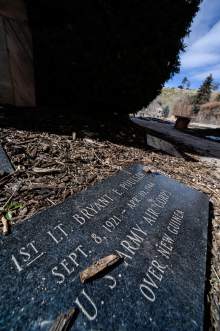This is an archived article that was published on sltrib.com in 2015, and information in the article may be outdated. It is provided only for personal research purposes and may not be reprinted.
Army Air Corps 1st Lt. Bryant E. Poulsen was shot down while flying his 51st mission of World War II.
It was April 10, 1944, and Poulsen, a 22-year-old from Salt Lake City, was the pilot of one of a dozen B-24s that took off from New Guinea on a mission to attack a Japanese anti-aircraft site at Hansa Bay.
Poulsen's plane was shot down over New Guinea's Madang Province. For about 6½ decades, that's all Poulsen's family knew.
But the Defense Department has spent years trying to find and identify Poulsen and his crew. On Tuesday, the military announced that Poulsen's remains had been found and will be interred March 18 at Arlington National Cemetery just outside Washington, D.C.
The events have come as a surprise to Jim Johnstun, a Poulsen nephew who had been in contact with the Defense Department. He said his maternal grandfather was a sheep herder near Fairview, Utah, and his mother, Poulsen and another aunt and uncle were born there. The family later moved to a home in Salt Lake City.
Johnstun remembers meeting his uncle once while Poulsen was wearing his uniform. Johnstun, now a 76-year-old resident of Caldwell, Idaho, assumes Poulsen must have been about to ship out.
Johnstun doesn't remember his mother or her two other siblings talking about Poulsen after his death. He doesn't remember his grandparents saying much, either.
"They essentially hated the Japanese," Johnstun said, "and that was it."
Poulsen's B-24 was nicknamed "Hot Garters." Four of the airmen from the plane parachuted from the plane, but were reported to have died in captivity, according to a Defense Department news release.
A military agency conducted an investigation of the wreckage after the war and recovered three of the missing airmen's bodies. Then, in 1949, the agency decided the remaining nine crew members were not recoverable.
In 2001, a new team returned to the site and found the B-24 with the correct tail number. After several surveys, teams excavated the site and recovered human remains and nonbiological material evidence, according to the news release.
Poulsen's three siblings had all died by the time a genealogist working for the Army contacted Johnstun about thee years ago. She and asked if Johnstun was a relative of Poulsen. He said yes.
"I was wondering what in the hell she was calling me for," Johnstun said. "She didn't really say."
The genealogist said someone from the Army would be contacting him. Sometime later, a woman from the Army called Johnstun. She explained about the wreckage and asked if she could visit Johnstun. She brought a book of photographs from the wreckage and took a DNA sample from Johnstun.
The DNA sample apparently was not helpful.
To account for Poulsen, scientists from the Defense POW/MIA Accounting Agency used circumstantial evidence that placed him on the aircraft and accounted for him as part of the group, according to the news release.
Johnstun said the photos showed how little was left of the wreckage. He is surprised the military was able to find any remains there.
"I was kind of astounded that they were still doing this," Johnstun said, "and that they had possibly found him."
Poulsen and another crew member, Staff Sgt. John E. Copeland, of Dearing, Kan., will be buried together in the March 18 ceremony. The whole B-24 crew will be honored, as well.
First Lt. William D. Bernier was buried Sept. 19, 2014, in Augusta, Mont. The other officer from the plane, Herbert V. Young Jr., was buried Oct. 15 in Prescott, Ariz.
Tech Sgt. Hugh F. Moore was buried Nov. 11 in Elkton, Md. Sgt. Charles A. Gardner, of San Francisco, was buried on Dec. 4 in Arlington National Cemetery.
Staff Sgt. Charles J. Jones will be buried Saturday in Athens, Ga. Tech Sg. Charles L. Johnston, of Pittsburgh, will be buried March 2 in Arlington National Cemetery.
Johnstun's son and another of Poulsen's nephews plan to attend the services at Arlington. Johnstun is not going. He said his family moved past Poulsen's death long ago, though he says things would be different if his mother or any of Poulsen's siblings still were alive.
"As far as grief or anything like that, no," Johnstun said of his feelings now. "It's been so long ago, it's just like reading a newspaper article."
Twitter: @natecarlisle



